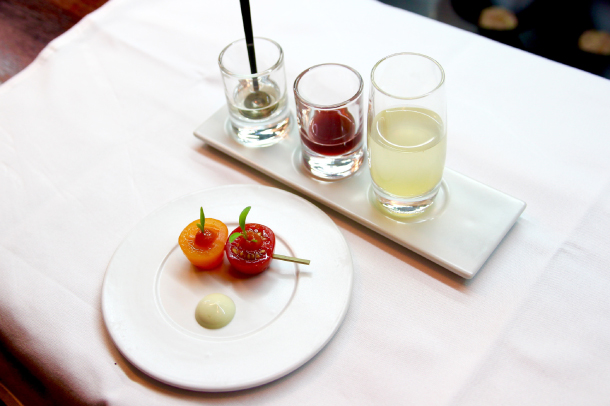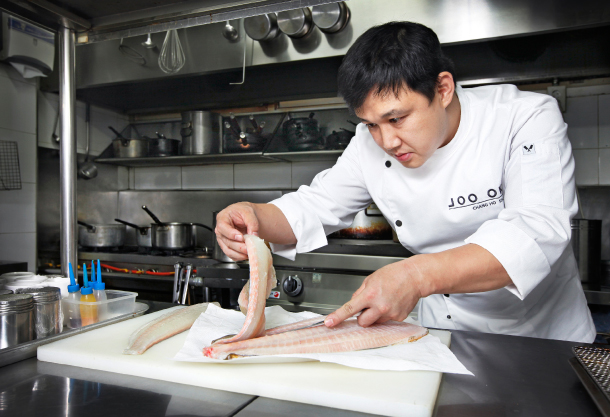Joo Ok uses vinegar to boost diner’s appetite

Restaurant Joo Ok is known for serving different styles of vinegar. [JOO OK]
That’s the approach modern Korean restaurant Joo Ok takes to differentiate itself from other restaurants that serve food under the similar concept of Korean food presented in Western style courses. Once diners are seated, they are served with either small bites with enhanced acidity or small glasses of different vinegars before their actual course meal starts. Usually two different kinds are served, including some made with omija (a berry indigenous to Korea), grapes, blueberry or pine buds. Diners are free to pour the whole thing into a glass of water and drink, or keep it until other dishes are served.
“I wanted to focus on making Korean food a foreigner could love,” said Shin Chang-ho, the executive chef of the restaurant. “A little twist can make a strong, spicy taste into something completely different.”
What he chose to make a first impression with is vinegar. Now that international attention has been given to Korean-style fermentation, more guests, especially foreign chefs, have shown interest in how Shin makes his vinegars and the varieties he makes. He usually has about 15 different types in stock and shares a bottle if a guest has seriously curious eyes. The vinegar made with omija is especially popular he said, adding that the berry’s distinct fresh and sour flavor seems to appeal to many. The particular berry, which is indigenous to Korea, got its name for having five different tastes, as oh in Korean means five and mi means taste.

Executive chef Shin Chang-ho of Joo Ok fillets fish in his restaurant’s kitchen in Gangnam District, southern Seoul. At left are some of the dishes served at his restaurant. [PARK SANG-MOON]
“I like the taste of vinegar in my food as it makes me feel like that particular food served is lighter,” said Shin who said his taste buds have changed from craving something heavy and big to something light and fresh.
At first, making vinegar was easy because he started with grapes without knowing that grape was one of the easiest ingredients to ferment with. The first batch of vinegars he made with other fruits were thrown away while some that had been forgotten in a corner of the kitchen turned out to be tasty two years later.
He simply didn’t know that vinegar has to be kept in cold temperatures to prevent over-fermentation. He struggled because there weren’t that many vinegar experts he could consult because Korea once forbade home-made alcohol, which is one step before ingredients become vinegar. He usually mixes yeast with squeezed fruit juice to first make an alcoholic juice, then mixes it with the basic vinegar he left over. With years of practice before and after the restaurant opened in 2016, he now produces a steady quantity and quality.
To show diners jars of vinegars available at the restaurant, he displayed them inside when he first opened. But now they are all gone and replaced with preserved ingredients used to make vinegar, as the jars attracted many flies.

Besides discovering his passion for acidity, he saw a need to make Korean food more approachable for foreign tastes. Just like Nobu adds its own twist to Japanese food to appeal to locals in the United States, Shin started to think that there could be a market for modified Korean cuisine.
“It wasn’t to give Korean food a face lift, I just wanted to develop the same ingredients in a different way,” said Shin. Just like people can have much easier time eating washed and pan-fried kimchi in kimchi fried rice instead of straight up kimchi, he wanted to discover recipes that can be more appealing to foreigners and new to Koreans.
One of the dishes he was surprised to learn about was fish mandu, or dumpling. Dumplings filled with cooked croaker and served with minced and chopped zucchini, shiitake mushrooms and tofu in an anchovy broth isn’t something he put together before, but the taste was comfortable.
“There seems to be a prejudice that Korean food is spicy, salty and comes in large portions without any detailed decorations,” said Shin. “But there are other dishes that aren’t as readily available at everyday restaurants, and that’s what I want to present at my restaurant.”
One of his dreams is to do Korean food overseas. His dream restaurant will be on a top of a hill in a city where the weather is mostly nice all year around and some herds of sheep can be seen in the distance. While he works overseas and try to add international influences to his dishes to cater to locals there, he hopes to see more foreign chefs open up restaurants in Korea and bring new trends to his motherland. That’s his other dream.
BY LEE SUN-MIN [summerlee@joongang.co.kr]










with the Korea JoongAng Daily
To write comments, please log in to one of the accounts.
Standards Board Policy (0/250자)